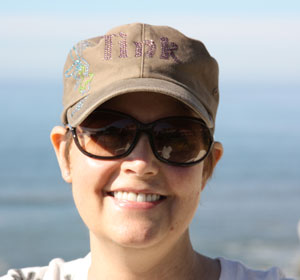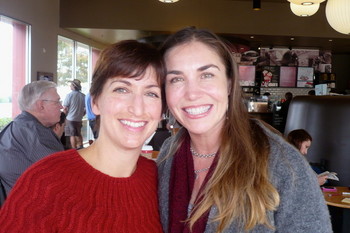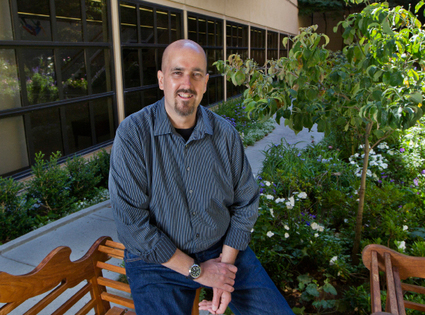January 2012
A Letter to Blood Donors
| Tweet |
The following letter was written by Michelle Moskalik in August, just three months before she passed away. Her family has been gracious in letting us share this with you.
I am an active 43 year old woman with a strong love for life. I am living with terminal breast cancer and acute leukemia (AML). As a result, I am transfusion dependent and now receive blood and platelets on a weekly basis.
I know I’m low on blood when my energy plummets, I’m unable to walk 5 feet without resting to catch my breath, and I don’t have the energy to do simple daily tasks or things that give me great pleasure (like walking my dog, traveling with my husband, or spending time with friends and family.)
Everything changes immediately when I receive blood. After about 10 minutes into the transfusion I feel the life spark returning. I have energy and vitality and feel like myself again. I often cry a little when I leave the ITA, partly because I am so happy to have my life back (if only for a little while until the next transfusion) but also as a thank you to the donors. I have no words to express how incredibly grateful I am to life saving and life giving donors like you who make such a difference in my life. Your selfless gift is a miracle to me. I am sincerely thankful for your great act of kindness and generosity.
As an aside, because I feel so great after getting blood, my friends think I’ve become a vampire. Further evidence:
• Aversion to sunshine: Hello! Wrinkles!
• Aversion to silver: Gold looks so much better with my skin tone.
• Must be invited into homes: have never tried breaking and entering, so not sure about this one. Not sure how to test this without being arrested.
• Have never been attacked by hot werewolf with 12 pack abs. Sad for me. Maybe I can get my husband to dress up.
To view the original letter, please visit Michelle's website.
Benefits of Blood Transfusions
| Tweet |
By Billie Rubin, Hemoglobin’s Catabolic Cousin, reporting from the labs of Stanford Blood Center
A unit of blood does so much for patients in need. The gift of life is donated, tested, processed and sent to hospitals’ transfusion service departments where more important work is done to ensure it is compatible with the recipient.
Once the unit is ready to go, it has a number of advantages to offer. These are some of the benefits your donated blood can provide for patients in need:
1. Increase low hemoglobin levels: low hemoglobin can cause damage to body organs and tissues due to low oxygen levels.
2. Help stop bleeding: bleeding may not be controlled if platelets and/or clotting factors are low.
3. Keep the heart pumping: low blood volume can lead to low pressure and the heart may not be able maintain the circulation of blood.
4. Help with serious blood infections when other methods fail. Granulocyte transfusions, for example.
5. Provide red cells and platelets when the bone marrow is compromised: as with blood cancers, bone marrow transplants, chemotherapy.
6. Provide red cells and platelets for patients with blood disorders: such as sickle cell, thallasemias, myelodysplasia, aplastic anemia.
7. Save someone’s life.
Los Gatos Friends 'Thicker Than Blood'
| Tweet |
By Bonnie Westman with the Los Gatos Patch.
Since 2006, Linda Swenberg and Michelle Abene donate platelets at Stanford Blood Center, in addition to significant volunteer work in the community.
Why would someone voluntarily give up two and half hours of their time every few months to be pricked by a needle, have blood drawn from their body causing discomfort as platelets are spun out and then watch the vital fluid returned to their person?
Because the precious gift could save a person's life, according to Los Gatos residents Linda Swenberg and Michelle Abene.
These sister friends have been donating platelets regularly at Stanford for several years—their contribution considered an important tool medical doctors have to help those undergoing treatment for serious health problems such as leukemia and cancer.
Swenberg has been donating since the late 1990s.
At first, she began her selfless act thinking that it was a good thing to do for others, while at the same time having a little bit of time off from her busy life at home with three young children.
Then a dear friend of hers was diagnosed with leukemia. The true importance of donating hit her hard when she found out that she was a match for her friend, so she started donating more often.
When Abene moved to Los Gatos in 2005, she didn’t know anyone. She met Swenberg and they quickly became good friends.
Soon after meeting, Swenberg asked Abene if she wanted to join her at Stanford. Abene said yes and they have been donation buddies ever since. After the procedure, the women often treat themselves to a nice lunch.
“Basically it takes a whole day by the time you drive up to Stanford, donate, have lunch and drive home, yet we have been doing it for years and enjoy the experience every time,” says Abene.
“I look forward to donating because it is time to relax, it is a very positive experience and the staff at Stanford takes good care of you,” says Swenberg.
While there, the women say they are surrounded by people who are doing good for others and feel special participating. Abene calls it a “reward for having a healthy life.”
Click here to read the full article on the Los Gatos Patch website.
#WhyIGiveBlood: So Patients Can Live More Comfortable Lives
| Tweet |
By Melissa Ramos, volunteer guest-blogger for Stanford Blood Center
John Paul Mayor is one of our very regular platelet donors. For our #WhyIGiveBlood campaign, we picked his brain about what inspired him to become a regular donor.
John Paul, or “JP” as he is known, started donating whole blood as a high school student in 2000, but it was not until he was 23 that he became inspired to be a regular donor. Through Team in Training, he had the opportunity to meet patients with blood cancers. Some might be content having raised over $7,000 for blood cancer research, but not him. He became a regular blood donor, knowing that these donations will help those patients live comfortably and normally. When he learned about donating platelets, and that he was eligible for this type of donation, he jumped at the opportunity and has become a regular fixture at our Centers since.
JP knows a thing or two about donations and has some tips to share:
• He prefers to donate on Mondays at Hillview, when he gets free movie tickets
• Staying hydrated leading up to your appointment helps speed up your donation time.
• Wearing a zippered hoodie will keep you warm and won’t get in the way during your donation.
JP has become a close friend of the staff at SBC. Not only does he make time to donate between his two jobs, but he has been known to show up with a home-made chocolate mousse cake covered in ganache from time to time.
What has inspired you to become a regular donor? Share your story with us!
The Safe Blood Africa Project: How SBC Donors Can Help
| Tweet |
By Amanda Baker, Communications Intern, Stanford Blood Center
This is part 3 of 3 in our series on the Safe Blood Africa Project.
Click here to read Article 1: The Safe Blood Africa Project: Background
Click here to read Article 2: The Safe Blood Africa Project: The Trip
Think globally, act locally…help globally? At Stanford Blood Center, each of these are possible because now your blood donation that will save a life in your community can also help save lives overseas. Our online store recently added an option of donating the points you receive for giving blood towards helping blood centers in Nigeria, as part of the Safe Blood Africa Project.
Donating your points towards Safe Blood Africa means assistance goes towards procuring items like new donor beds. One of Safe Blood Africa’s goals is to recruit more voluntary blood donors, because the use of paid blood donors is thought to more likely lead to the transmission of blood-borne diseases like hepatitis, malaria, HIV, and other diseases. Making blood centers more inviting and comforting will encourage healthy eligible donors to make donations that help save the lives of local patients in need. At present some Nigerian donors have to donate on flat cots lying on their backs (that is, if they have cots at all). Comfy donors beds could thus make a big difference in attracting volunteer donors to give blood.
In addition to donor beds, donated points might also go towards vehicles for mobile blood drives, laboratory equipment like pipettes and donor scales, and other items that will help make a Nigerian donor’s experience a pleasant and safe one. The delivery of these items, as well as the training required for phlebotomy and blood storage, is handled by employees from BloodSource in Sacramento and representatives from the Carmel Valley Rotary Club.
Give blood for life to help save lives at home and abroad!
Update, Spring 2012:
The overwhelming response in number of point donations from our blood donors had our allotted funds for these programs maxed out within a few months. But the donations have gone a long way! Read more here.
But I Was in Such a Good Mood This Morning!
| Tweet |
Rob Henslin is a bone marrow transplant survivor and close friend of Stanford Blood Center. He spends much of his time volunteering for the national bone marrow registry, inspiring audiences with his story, and making amazing plates of brownies.
In 1989, just six months after marrying my young bride, I was diagnosed with Acute Lymphoblastic Leukemia. My wife and I were thrust into the world of cancer, and we watched our hopes and dreams shatter in an instant. At twenty-six years of age, I was told by doctors at the City of Hope National Medical Center that my prognosis was “poor.” But after nearly a year and a half of intensive chemotherapy, brain radiation, bone marrow biopsies and countless other procedures, I emerged on the other side of my disease, in remission and thankful for the blessing of each new day.
Thanks in large part to the numerous transfusions of whole blood, platelets, and plasma I received both as an inpatient and over the course of my outpatient treatment, I was given a second chance at life. My wife and I were granted an opportunity to grow our young relationship; a relationship that had been strained by changing roles and responsibilities, when I became the patient, and my wife became my caregiver.
When I first learned I had leukemia, I was told that because of the nature of chemotherapy, my wife and I would most likely not be able to have children. But in 1992, we were blessed with a miracle daughter. Two years later, a second daughter joined our family, and I began to entertain thoughts that perhaps I was out of the woods, that the cancer monkey asleep on my back might not ever awaken from his long slumber.
But the monkey did wake up. After nearly twenty years in remission, my leukemia returned. On October 20, 2008, I learned the grim news and was told I would need a bone marrow transplant to have any chance of long-term survival. Following several months of chemotherapy and a series of spinal taps, I received the best Christmas gift ever—news that not one but four bone marrow donors had been found; all perfect matches across the ten genetic markers used to assess potential donor compatibility.
I received my bone marrow transplant on February 10, 2009, at Stanford Hospital’s E1 Transplant Unit. After 48 days in isolation I was discharged to begin a long road to recovery. I faced numerous setbacks and complications in that journey, but after two and half years, I am thankful to be alive, and to have the opportunity to return to some semblance of a normal life. But I will never be the same.
I spent the better part of my professional career working in the graphic arts, publishing, and marketing communications fields. I still have a passion for my craft, but after my cancer odyssey, I find myself drawn to pay it forward—to do everything I can to help other cancer patients and those in need of a bone marrow transplant. I volunteer my time to assist the Be The Match National Marrow Registry, registering potential donors at drive events and speaking on behalf of the organization as well. I also donate my time to help the Stanford Blood Center to ensure other patients receive the precious gift of life through blood and blood product donations.
Rob’s professional work has garnered numerous industry awards, including Silver Six Awards of Excellence from the International Association of Business Communicators, a Citation of Excellence from the American Advertising Federation, and Joey awards from the San Jose Film and Video Commission.
In addition, he has written a memoir to tell the compelling story of the twenty-year cancer odyssey he and his wife and family endured, and share the many blessings they received even in the darkest of times. “But I Was in Such a Good Mood This Morning!” is now available on Amazon.com and Createspace.com.
To contact Rob about speaking at your upcoming church, school or civic event, email him at rob@post-traumaticpress.com. For more information, visit www.post-traumaticpress.com.
Rob is featured here in a short video, part of our "From the Heart" series:






